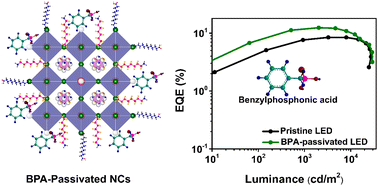Optimizing the content of inherent capping ligands in perovskite nanocrystals (PeNCs) is a crucial strategy for enhancing the performance and stability of perovskite light-emitting diodes (PeLEDs). However, the highly dynamic adsorption–desorption state of capping ligands and their detachment from the surface of PeNCs often result in degraded optical properties and the emergence of surface defects. In this study, we investigated the use of benzylphosphonic acid (BPA), an aromatic conductive molecule, for passivation to replace the native capping ligands of FAPbBr3 NCs. Comprehensive characterization results validate that the original long insulative ligands were partially substituted with short conductive phosphine oxide functional groups, effectively passivating the nonradiative defects of FAPbBr3 while enhancing electron injection into perovskite emitting layers. Moreover, this proposed ligand-exchange strategy significantly improved the photoluminescence quantum yield of FAPbBr3 NCs. Consequently, we achieved a high-performance PeLED with an external quantum efficiency of 12.9% at 4660 cd m−2 using BPA-passivated FAPbBr3 NCs. These findings underscore the potential of post-passivated PeNCs via aromatic acid in fabricating high-performance optoelectronic devices.
